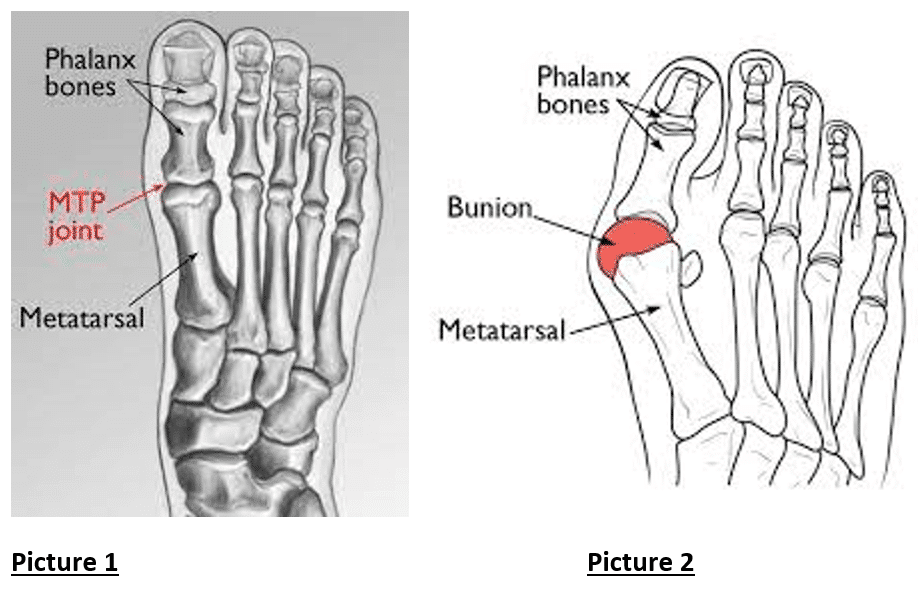Do you hide your feet because of your bunions? Listen, your feet shouldn’t be a deal-breaker. No guy ever has said, “Leave your socks on”.
Do I have a bunion?
Bunions or Hallux Valgus is a very common foot problem. It’s a common misconception that your shoes cause bunions. Actually, it’s more due to your genetics. That’s right, thanks mom and grandma for your lovely gift. Bunions can be mild, moderate or severe and you mild one can hurt like crazy and the most severe can be completely pain free and it can also be the complete opposite. Either way bunions can be a pain in the foot. Let’s face it, pretty feet should be your reality and not your vision board.
What is a Bunion?
Let’s talk anatomy. Your big toe consists of three bones. Your metatarsal, your proximal phalanx and your distal phalanx (See Picture 1). A bunion is where the metatarsal begins to move inwards towards the midline of the body and the toe then drifts towards the second toe (Picture 2). The large bump that forms over the great toe joint is the actual bunion. Studies show that up to 23% of people ages 18-65 have bunions and for those over 65 it can be as high as 35%. As the metatarsal drifts medially or inwards and the toe drifts outwards there is a lot of stretching and stress placed along the toe joint. The weakens the joint and can even wear down the cartilage causing the bunion to get progressively worse.

Why did I get the bunion?
70% of bunions have a positive family history. They are more common in women vs. Men. However, there are risk factors that can contribute to the bunion. Those are things such as ligamentous laxity, the shape of the great toe joint, flat feet, Rheumatoid arthritis, as well as shoes with a narrow toe box and high heels.
Is the bunion just new bone growth or a spur?
No. A bunion is actually more a dislocation or subluxation of the big toe joint. In the past, you may have been told that you have extra bone growth along the inside of the toe. However, it is actually just the normal bone sticking out. This causes your shoes and other things to rub on the prominent bone causing pain and discomfort.
How are bunions treated without surgery?
In order for a bunion to be fixed it has to be done surgically. However, if you are not ready for surgery there are things that can help. First of all, those bunion splints you see online may help some but for the most part, I find they just make the area more painful. I recommend padding with foam or silicone bunion pads. Check out www.elitefaor.com if you are looking to purchase some. Also, buying good shoes with a wide toe box can also keep the area from rubbing. Toe spacers also help if your bunion is pushing up against the second toe.
Is bunion surgery painful?
Surgery is always painful but it doesn’t have to be severe and it doesn’t have to last two months. Depending on the surgery performed, it can be mild to moderate pain or even severe.
How do you determine what surgery I need?
Every doctor has their ways of surgically fixing bunions. Here at Elite Foot & Ankle we really use two methods. We use the Lapiplasty technique. This is a new technique of an old procedure. This involves fusion of a joint in your midfoot. This joint is typically the main source of the bunion. By addressing the bunion here, the benefits are more stable correction and you almost eliminate any chance of the bunion coming back. With the Lapiplasty you can walk day one and by 6 or 8 weeks you are back in regular shoes.
The other way we fix bunions is by Minimally invasive surgery. This involves three small tiny stab incisions. This surgery is great for younger patients and older patients. It avoids large skin incisions and really minimizes the pain. You can also walk right away with the procedure and back in regular shoes in 6-8 weeks.
Finally, if your toe has severe arthritis then we typically have to fuse the big toe joint in order to eliminate the bunion and eliminate the pain from the arthritis in the joint. This is a very good procedure. You may be thinking, that’s crazy and how can I walk with my big toe joint fused. You’ll be surprised at what you can do with a big toe joint. With these usually patients already have a stiff joint so you won’t even know the difference.
Fix your bunion now and you’ll be posting cute foot selfies by June.
If you have a bunion and would like to see about your options, call us at (503) 668-5210 or visit us at www.bunioncentersoforegon.com. You can also visit www.fixmytoe.com to learn more about the Lapiplasty procedure. This summer, rock those skimpy sandals. You’ll have the feet for it.

